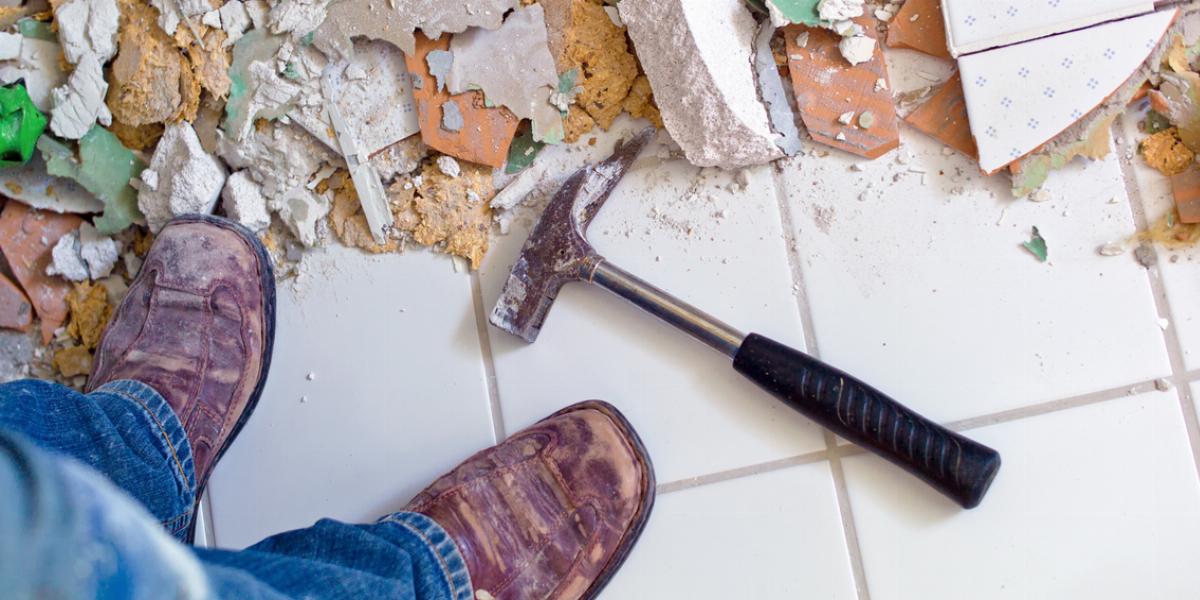
Dreaming of a spa-like bathroom, but your old flooring squashes your Zen?
Whether it’s peeling linoleum or outdated vinyl, replacing your bathroom floor will quickly modernize your space. This two to three-day remodeling project will not only impress guests but can also increase your home’s value.
Flooring materials for the average bathroom typically cost between $100-$500, depending on your selections. Hiring a professional for the installation can double or triple your expenses, so this project can be a cost-effective option for the intermediate to expert DIYer.
So how do you lay tile yourself? Well, we called in the experts – Allie Bloyd of Builders Surplus and James Upton, the DIY Tile Guy – to provide helpful tips and advice. Let’s start with the supplies.
| Tools | Materials |
|
|
If you don’t have these tools on hand, visit your local home improvement store and ask about tool rentals.
In addition to towels, toothbrushes and decorative items, you’ll need to take out some bathroom fixtures to give you room to work. Remove these items to prep your bathroom:
Prep work complete? Great, let’s move on to the main event.
Measure your bathroom wall-to-wall to figure out how much tile, grout and underlayment to buy. For the correct amount of tile, calculate the square footage of your room. After you select your tile, determine how many tiles you need per square foot. Consider purchasing a few extra tiles to allow for breaks or cutting mistakes.
More often than not, neutral colors are the way to go, especially if you plan on selling your home. Also, be sure to select a tile that can handle a lot of foot traffic.
“Go for a look that you know you'll love for decades if need be. Something that will still match your vanity if you decide to change it down the road.”
Allie Bloyd | Builders Surplus
It’s also important to pick a material that can handle water. That means not too slippery or too porous. James Upton, the DIY Tile Guy, points out that some types of tiles easily absorb water, shampoo and soap, making them a bad choice for the bathroom.
“Many times, people want to select a natural stone, such as marble, travertine and granite. While these products look great, more often than not, they are maintenance intensive and people don't usually understand what they are getting themselves into.”
James Upton | DIY Tile Guy
So, what material do the experts recommend? A great option is porcelain.
“It's more durable than ceramic,” Bloyd says. “If it chips or cracks, it won't be as noticeable because porcelain tile is the same color all the way through typically. Ceramic is usually red or another color in the body with a paint or glaze on top.”
To keep your new tile from cracking, thoroughly prepare the surface. If you’re removing old tiles, consider renting a renovation dumpster and make sure to vacuum away the dust and debris.
You can lay tile over linoleum or vinyl. If you go this route, keep these tips in mind:
Pro-Tip: Always wear gloves and eye protection while working with cement and chemical products. These materials can dry out bare skin or cause chemical burns.
A layer of cement backerboard provides a clean, even surface to lay bathroom tile. Plywood backerboard also works, but experts recommend the sturdier cement option. This will offer the best support for heavy tiles. To install cement backerboard:
“Make sure you have a very level subfloor if you're installing stone tile. It's heavier than other tile and can crack if it's not level.”
Allie Bloyd | Builders Surplus
It’s a good idea to dry-lay the tile first to decide on the best layout. Start in the center and work your way out, keeping spaces between the wall and tile even. Don’t begin at a wall. This may seem easier, but you may have to cut tile very thinly at the opposite wall. For best results, here’s how to lay floor tile:
How to Use Tile Spacers
To achieve a professional look, follow these tips for tile spacers:
Use your tile saw to cut the tiles down to the sizes you measured in the previous step. Test a few before cutting all of them to make sure you have the proper measurements. Dry-lay all cut tiles for a final quality check before installation.
Remove tiles from your layout section by section and place in an organized pile. Using a notched trowel, spread a thin layer of thin-set mortar in small segments at a time. Replace tiles with the tile spacers so they stay in position. Once the floor is completely covered, let the mortar dry for a full 24 hours.
”Make sure you ‘butter’ the back of your tile when laying floor tile. This is rubbing a thin layer of mortar on the back of your tile in addition to the mortar on the floor. This ensures a better hold.”
Allie Bloyd | Builders Surplus

Image Credit: Allie Bloyd
The next day, carefully remove the tile spacers. Mix your grout following the manufacturer’s instructions. Using a grout float, neatly fill the spaces between each tile. Once completely applied, wipe away surplus grout using a damp sponge. Allow another 24 hours for the grout to dry, then apply a grout sealer to protect from chips and stains.

Image Credit: Allie Bloyd
Reinstall doors, trims and fixtures. Wipe down floors once more and replace rugs and bathroom décor. Voila! Your bathroom is ready for luxurious bubble baths aplenty.
Ready to take on more DIY projects? Check out the For the Home section of our blog to find a project for next weekend!
